

Parks Canada-The Underground Railroad in Canada. Jermain Wesley Loguen - New York History Net. Jermain Wesley Loguen was born into slavery in Tennesee.
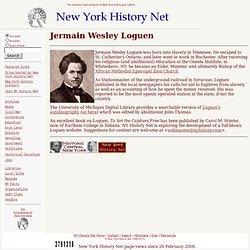
He escaped to St. Catherine's Ontario, and later went to work in Rochester. Harriet Tubman Life. Harriet Jacobs. It was not Harriet Jacob's nature to give up without a fight.
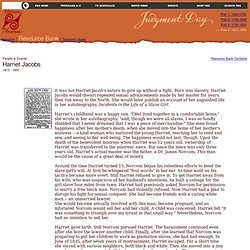
Born into slavery, Harriet Jacobs would thwart repeated sexual advancements made by her master for years, then run away to the North. She would later publish an account of her anguished life in her autobiography, Incidents in the Life of a Slave Girl. Harriet's childhood was a happy one. "[We] lived together in a comfortable home," she wrote in her autobiography, "and, though we were all slaves, I was so fondly shielded that I never dreamed that I was a piece of merchandise.
" She even found happiness after her mother's death, when she moved into the home of her mother's mistress -- a kind woman who nurtured the young Harriet, teaching her to read and sew, and seeing to her well-being. Around the time Harriet turned 15, Norcom began his relentless efforts to bend the slave girl's will. Harriet gave birth. William Wells Brown. William Wells Brown (November 6, 1814 – November 6, 1884) was a prominent African-American abolitionist lecturer, novelist, playwright, and historian.
Born into slavery in Lexington, Kentucky, Brown escaped to the North in 1834, where he worked for abolitionist causes and was a prolific writer. His novel Clotel (1853) is considered the first novel written by an African American; it was published in London, where he was living at the time. Brown was a pioneer in several different literary genres, including travel writing, fiction, and drama. He has a school named after him in Lexington, and was among the first writers inducted to the Kentucky Writers Hall of Fame.[1] Brown was lecturing in England when the 1850 Fugitive Slave Law was passed in the US; he stayed overseas for several years to avoid the risk of capture and re-enslavement. Life in slavery[edit] William was born into slavery in 1814 in Lexington, Kentucky, as his mother Elizabeth was a slave.
Marriage and family[edit] [edit] Samuel J. May - New York History Net. John Brown Homepage. Gerrit Smith Virtual Museum - New York History Net. Aboard the Underground Railroad. Built in 1836, St.
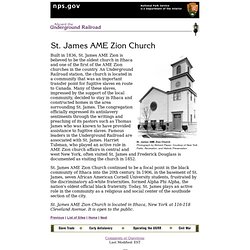
James AME Zion is believed to be the oldest church in Ithaca and one of the first of the AME Zion churches in the country. An Underground Railroad station, the church is located in a community that was an important transfer point for fugitive slaves en route to Canada. Many of these slaves, impressed by the support of the local community, decided to stay in Ithaca and constructed homes in the area surrounding St. James. The congregation officially expressed its antislavery sentiments through the writings and preaching of its pastors such as Thomas James who was known to have provided assistance to fugitive slaves.
St. Harriet Tubman Home - New York History Net. The Harriet Tubman Home The Harriet Tubman Home preserves the legacy of "The Moses of Her People" in the place where she lived and died in freedom.
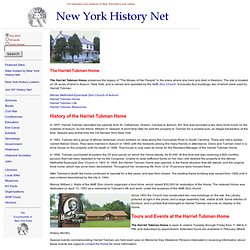
The site is located on 26 acres of land in Auburn, New York, and is owned and operated by the AME Zion Church. It includes four buildings, two of which were used by Harriet Tubman. African Methodist Episcopal Zion Church of AuburnHarriet Tubman HomeHarriet Tubman LifeHarriet Tubman Resources. John Brown Farm, North Elba, New York - New York History Net. In 1848, John Brown traveled to Peterboro to introduce himself to Gerrit Smith.
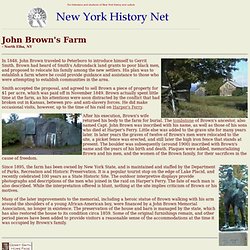
Brown had heard of Smith's Adirondack land grants to poor black men, and proposed to relocate his family among the new settlers. His plan was to establish a farm where he could provide guidance and assistance to those who were attempting to establish communities in the area. Smith accepted the proposal, and agreed to sell Brown a piece of property for $1 per acre, which was paid off in November 1849. Brown actually spent little time at the farm, as his attentions were soon distracted by the conflict that had broken out in Kansas, between pro- and anti-slavery forces. He did make occasional visits, however, up to the time of his raid on Harper's Ferry. Incident in Troy, New York. Click here for the text of this historical document.

Harriet Tubman, a fugitive slave who personally escorted over 300 slaves to freedom, was known for thinking her way through perilous situations. Her ingenuity is illustrated in an incident that occured in 1860 in Troy, New York, in which she set her mind to setting free a fugitive who had been captured and was being held at the office of the United States Commisioner. The slave, a man named Charles Nalle, did escape thanks to Tubman's efforts. He later bought his freedom from his master, a man who also happend to be his younger, half-brother. Dred Scott case. Click here for the text of this historical document.

In March of 1857, the United States Supreme Court, led by Chief Justice Roger B. Taney, declared that all blacks -- slaves as well as free -- were not and could never become citizens of the United States. Thirteenth Amendment to the United States Constitution. The Thirteenth Amendment to the United States Constitution abolished slavery and involuntary servitude, except as punishment for a crime.
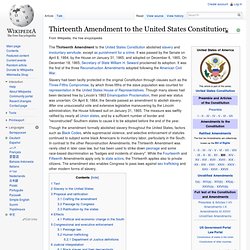
It was passed by the Senate on April 8, 1864, by the House on January 31, 1865, and adopted on December 6, 1865. On December 18, 1865, Secretary of State William H.